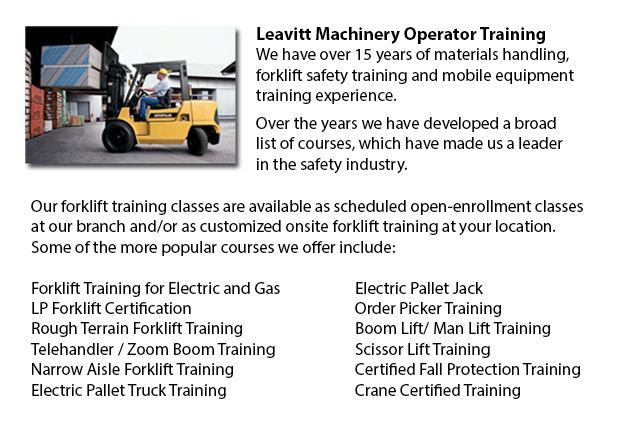
Oshawa Forklift Training Schools - Know How To Operate A Forklift Correctly With Our Forklift Training Schools
Are you looking for work as a driver of a forklift? Our regulatory-compliant mobile equipment operator training provides instruction in kinds of lift trucks, pre-shift check, fuel types and dealing with fuels, and safe utilization of a lift truck. Practical, hands-on training helps people participating in obtaining basic operational skills. Program content covers current rules governing the use of forklifts. Our proven forklift courses are intended to provide training on these kinds of trucks: powered pallet truck, narrow isle forklift and counterbalanced forklift.
While the lift truck is in use, do not raise or lower the forks. Loads must not extend above the backrest. This is because of the risk of the load sliding back towards the operator. Inspect for overhead obstructions and ensure there is plenty of clearance prior to lifting a load. Stay away from overhead power lines. When the load is lifted straight up, tilt it slightly back.
The lift truck is less stable if a load is in a raised position. Make certain that no body ever walks below the elevated fork. The operator should not leave the lift truck while the load is raised.
The forks must be level when handling pallets, and high enough to extend all the way into and under the load. The width of the forks should provide equal weight distribution.
Prior to loading or unloading the truck, chock the wheels and set the brakes. Floors need to be strong enough to support the weight of the load and the forklift combined. Fixed jacks could be installed in order to support a semi-trailer that is not attached to a tractor. The height of the entrance door must clear the forklift height by at least 5 cm. Mark edges of rail cars, ramps or docks and avoid them.
-
Oshawa Scissor Lift Operator Certification
Oshawa Scissor Lift Operator Certification - North American regulators recommend that worksites need operators of scissor lifts, booms or aerial work platforms to obtain certification training. Scissor lift operator certification is not mandatory, bu... More -
Narrow Aisle Forklift / Order Picker Training / Electric Pallet Jack / Electric Pallet Truck Training in Oshawa
A pallet lift is a model of equipment dedicated in the moving of pallets of many dimensions and weights. They might be utilized as an appendage for platform lifts, cranes and other types of heavy machinery or be applied on their own. Pallet hoists ar... More -
Oshawa Crane Operator Certification
Oshawa Crane Operator Certification - The process to permit people to be able to operate certain kinds of cranes is to take crane operator certification training to get certification. The certification process incorporates classroom learning, hands-o... More -
Oshawa Aerial Platform Training
Oshawa Aerial Platform Training - Aerial platform lifts might be utilized to accomplish a lot of unique tasks executed in hard to reach aerial places. A few of the odd jobs associated with this style of lift include performing routine repair on build... More -
Oshawa Forklift Certification Schools
Oshawa Forklift Certification Schools - Forklift Certification is mandatory within North America. Hence, forklift training programs are important both for companies and for people seeking jobs in industries as forklift operators. Forklift training fo... More -
Oshawa Heavy Equipment Ticket
Oshawa Heavy Equipment Ticket - Depending on the nature of the job at hand, the type of construction equipment that a heavy equipment operator makes use of varies. Each and every type of machine is built to perform specific jobs in the most effective... More -
Oshawa Heavy Equipment Certification
Oshawa Heavy Equipment Certification - Large pieces of machines and heavy-duty vehicles are usually known as heavy equipment. This broad term includes utility vehicles from forestry and agricultural implements to civil engineering vehicles, construct... More -
Oshawa Overhead Crane Safety Training
Oshawa Overhead Crane Safety Training - The overhead crane safety training program is meant to equip the operators with the right skills and knowledge in the areas of: crane safety precautions, accident avoidance, materials handling, and equipment an... More

Forklift Certification Oshawa
TOLL FREE: 1-888-254-6157
Oshawa, Ontario
forkliftcertificationoshawa.com
Email Us
About Us


